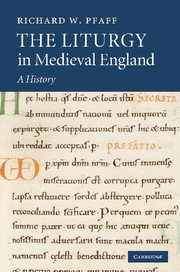Book contents
- Frontmatter
- Contents
- Preface
- Sigla and editorial conventions
- Bibliographical abbreviations
- Nicknames for manuscripts frequently referred to
- 1 Introduction
- Excursus: on sources
- 2 Early Anglo-Saxon England: a partly traceable story
- Excursus: on the terms Gregorian and Gelasian as used here
- 3 Later Anglo-Saxon: liturgy for England
- 4 The Norman Conquest: cross fertilizations
- Excursus: on method in the comparison of liturgical texts
- 5 Monastic liturgy, 1100–1215
- Excursus: on ascription of liturgical books to specific churches
- 6 Benedictine liturgy after 1215
- 7 Other monastic orders
- 8 The non-monastic religious orders: canons regular
- 9 The non-monastic religious orders: friars
- Excursus: on liturgical books from female religious houses
- 10 Old Sarum: the beginnings of Sarum Use
- 11 New Sarum and the spread of Sarum Use
- 12 Exeter: the fullness of secular liturgy
- 13 Southern England: final Sarum Use
- 14 Regional Uses and local variety
- 15 Towards the end of the story
- Index of Manuscripts
- Index of Saints
- General Index
10 - Old Sarum: the beginnings of Sarum Use
Published online by Cambridge University Press: 20 March 2010
- Frontmatter
- Contents
- Preface
- Sigla and editorial conventions
- Bibliographical abbreviations
- Nicknames for manuscripts frequently referred to
- 1 Introduction
- Excursus: on sources
- 2 Early Anglo-Saxon England: a partly traceable story
- Excursus: on the terms Gregorian and Gelasian as used here
- 3 Later Anglo-Saxon: liturgy for England
- 4 The Norman Conquest: cross fertilizations
- Excursus: on method in the comparison of liturgical texts
- 5 Monastic liturgy, 1100–1215
- Excursus: on ascription of liturgical books to specific churches
- 6 Benedictine liturgy after 1215
- 7 Other monastic orders
- 8 The non-monastic religious orders: canons regular
- 9 The non-monastic religious orders: friars
- Excursus: on liturgical books from female religious houses
- 10 Old Sarum: the beginnings of Sarum Use
- 11 New Sarum and the spread of Sarum Use
- 12 Exeter: the fullness of secular liturgy
- 13 Southern England: final Sarum Use
- 14 Regional Uses and local variety
- 15 Towards the end of the story
- Index of Manuscripts
- Index of Saints
- General Index
Summary
It is probable that the single best known phrase pertaining to medieval liturgy in England is “Sarum Use.” The phrase refers in the first instance to the medieval services at the present Salisbury cathedral, and, more generally, to the totality of rubrics, texts, and saints – eventually, even styles of vesture and certain liturgical colors – supposed to derive from that model. This sounds very neat, and, as it is widely known that that cathedral began to be built in 1225 and was largely finished (save for the spire) in three decades, it is natural to suppose that a new rite was confected for the new building, and even that the articulation of this rite was accomplished by one person: Richard Poore, whose work will be treated mainly in the next chapter.
The actual story turns out to be much more complex, and indeed is by no means perfectly clear at present. It begins in 1075, when, as part of a royal post-Conquest policy of moving centers of dioceses from (more) obscure locations to places that seemed for one reason or another more logical, the headquarters of what had originally been the West Wessex diocese centered for the most part at Sherborne was moved to the hill-fort site usually known today as Old Sarum – the conventional term, retained here so that “Salisbury,” if not otherwise qualified, can be reserved for the new city and church, extant from roughly 1225.
- Type
- Chapter
- Information
- The Liturgy in Medieval EnglandA History, pp. 350 - 364Publisher: Cambridge University PressPrint publication year: 2009



